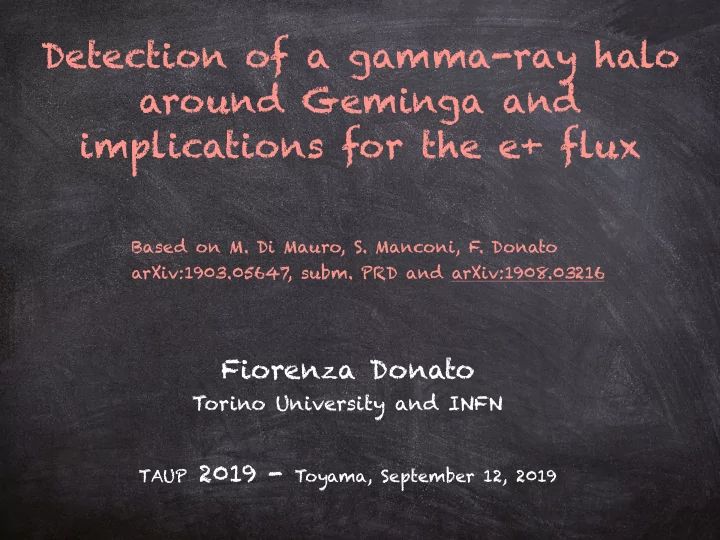

Detection of a gamma-ray halo around Geminga and implications for the e+ flux Based on M. Di Mauro, S. Manconi, F . Donato arXiv:1903.05647, subm. PRD and arXiv:1908.03216 Fiorenza Donato Torino University and INFN TAUP 2019 - Toyama, September 12, 2019
Introduction to the talk •The positron flux shows (Pamela, AMS data) the need of primary source at high energies. Pulsars could do the job. Di Mauro, FD, Fornengo, Vittino, Lineros JCAP 2014; AMS Coll. PRL 2019s Di Mauro, FD, Fornengo, Vittino JCAP 2016 e /(e +e ) 10 0 3 σ band II PWN TOT PWNe AMS-02 2014 PAMELA FERMI e + /(e + +e - ) 10 -1 σ 10 -2 10 1 10 2 10 3 E [GeV] [AMS-02 Coll, PRL122 (2019)] •HAWC has detected a TeV gamma-ray halo around Geminga and Monogem pulsars. Interpreted as e+e- accelerated by the pulsar, then released in the ISM HAWC Collaboration, Science 358, 2017 Milagro, Abdo et al., ApJL 2009 σ σ σ
Multi-wavelength emission from Pulsars • e ± pairs accelerated by Pulsar Wind Nebulae (PWN) loose energy by inverse Compton scattering (ICS) on background photons (CMB, IR, VIS) and by synchrotron emission -> photon PRODUCTION A cascade of photons, in a broad E range. Now also in γ rays [Sudoh+1902.08203] •e ± suffer strong radiative cooling —> they probe LOCAL Galaxy, typically < 5 kpc for E > 10 GeV • e+ from PWN are candidates to explain the e+ excess in Pamela and AMS data
What we learn from HAWC data Di Mauro, Manconi, FD 1903:05647, Hooper+1702.08436, Fang+1803.02640 Sudoh+1902.08203, Johannesson+1903.05509, Tang+1808.02445 , •The e ± injection is continuous (not burst-like) •The spin-down luminosity converted into HAWC high energy e+e- is η W 0 = 1.5 10 48 (4.2 1s 46 ) erg for Geminga (Monogem) •The diffusion is inhibited around the pulsar by ~ 500 times wrt the average in the ISM: D0(1 GeV) + 5 10 25 cm 2 /s Geminga surface brightness dist = 250 pc halo extension ~ 4 o
Which e ± produce HAWC photons? Fermi-LAT Fermi-LAT HAWC The fit to HAWC surface brightness The HAWC data do not constrain the comes with uncertainties / degeneracies e+ measured by experiments (AMS02) The extrapolation down to Fermi-LAT The e ± injection power spectrum is one energies gives remarkable differences key parameter
Searching for γ -rays at lower energies around Geminga • We implement a ICS template with background ISRF • Pulsar proper motion: v T =211 km/s (Faherty+AS2007) (70 pc travelled) Without proper motion With proper motion
Detection of a γ -ray halo in Fermi-LAT data around Geminga •We detect a γ -ray halo around Geminga at 7.8-11.8 σ depending on background models. •Fit improves with proper motion included. •Diffusion D(1GeV) = 1.6-3.5 10 26 cm2/s (comp. HAWK) • Extension ~ 60 pc at 100 GeV • γ e = 1.8-2
Halo extension depends on energy and diffusion Smaller haloes at higher energies Higher diffusion coefficients get the halo spread out. ISM D(E) values (~ 10 28 cm2/s) would get low energy γ -rays around Geminga spread widely in the ISM (no longer a halo….)
Consequences for e+ at the Earth 2-zones diffusion model: r b is the boundary between low and high diffusion zones Geminga contributes few % to the e+ flux at the Earth. The ICS halo is about 80 pc at Fermi-LAT energies
Open questions • Do all, or most of, the pulsars produce e+e-? • And with what efficiency? •Are all the pulsars embedded in a low-diffusion environment? •Is there an ICS halo around all them? An attempt to partially answer in M. Di Mauro, S.Manconi, FD arxiv:1908.03216
γ -ray haloes: a general property of pulsars? M. Di MAuro, S. Manconi, FD arxiv:1908.03216 We select sources from ATNF catalog with highest ICS halo above 1 TeV Compute the number of sources above HESS, HAWC and CTA sensitivity as a function of η , efficiency conversion into e ± . Tens of haloes could/will be detected even with 1% efficiency
A low diffusion zone around PWNe We select sources detected mainly by HESS (they provide flux maps) Interpret the data in terms of ICS halo and fit D(1TeV) and size The diffusion coefficient around PWNe is systematically lower by 2 orders of magnitude w.r.t. the ISM diffusion coefficient found from CR data (B/C).
ICS TeV Haloes have typical size We fit also the ICS halo size The trend with the age is compatible with models of PWN evolution The low diffusion zone around PWN should be larger than the halo size We find that the size of ICS haloes is about 35 pc
Conclusions • We discover an ICS γ -ray halo around Geminga pulsar (U.L. for Monogem) in the Fermi-LAT data at 8-100 GeV . Consistent with the HAWC measurement at > 8 TeV • Evidence of e ± diffusing away from PWN • Geminga contribute few % to the e+ flux data • Diffusion is found inhibited around several TeV PWNe • Tens of ICS γ -ray haloes could be found in HESS, HAWC and future CTA data
Recommend
More recommend